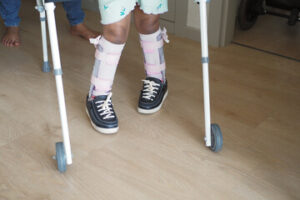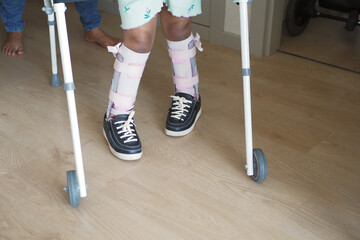Millions of children with mobility limitations experience problems while walking. These individuals can benefit from the use of a pediatric walker to improve their gait structure and help them navigate the environment better.
Almost all Pediatric Walker is lightweight, which means that they’re easy to maneuver and handle. This feature can also prevent the wearer from getting tired quickly.
Many children with physical impediments require a junior walker trainer in order to improve their mobility. Whether they are born with a disability or develop one due to an accident or injury, their limited mobility can lead to muscle atrophy, making it difficult to get around. However, with the right walker, they can build their strength and confidence to become independent and active again.
Compared to adult walkers, pediatric models typically have a more flexible height adjustment feature that allows you to easily adjust the base to match your child’s frame. The walker’s handles should be positioned so that the top is aligned with your child’s wrists or crease of their elbow. This ensures that the walker is easy to maneuver and doesn’t place undue strain on your child’s arms, shoulders or back.
For convenience, a number of pediatric models also fold down for storage and travel. This makes them easy to take on trips, outings or family gatherings. Depending on the model you choose, this may be possible by simply pushing down on a button or lever with your hand. Some models feature a locking mechanism that converts the front swiveling casters into fixed ones, allowing your child to take firmer steps as they progress through their environment. The pediatric walkers also feature a durable aluminum frame that offers lightweight yet sturdy construction for optimal comfort and performance.
Customization
Pediatric walkers are a useful tool that provides support and stability to children who may need help moving around. They are lightweight and adjustable, allowing them to be customized for the child’s specific needs. When selecting a pediatric walker, it is important to consider the child’s age, height, weight, and level of mobility. In addition, it is also advisable to consult with healthcare professionals such as a physical therapist to ensure that the device meets the child’s individual requirements.
Ensuring the proper sizing and fit of a pediatric walker is essential to promote safety, comfort, and optimal use. Two important considerations in this regard are the height adjustment and weight capacity. Pediatric walkers should be adjusted to the appropriate height for the child using them, allowing them to maintain proper posture and balance while walking. In addition, the walker should be able to support the child’s weight without exceeding the recommended maximum limit.
Other important features to consider include maintenance and durability, as well as supportive accessories. For instance, opting for a walker that is foldable can be highly beneficial, as it can easily be collapsed for transport and storage. Additionally, the walker should be made from high-quality materials that can withstand frequent usage and ensure longevity. Moreover, the walker should be equipped with non-slip grips and brakes to offer the child with a comfortable and secure grip.
Safety Features
Although the use of support walkers has been shown to improve quality of life (QOL) among children with mobility limitations, it is important for healthcare professionals to consider the potential risks when prescribing this type of device. This includes the risk of falls and other injuries related to poor positioning in the device.
In addition to considering the walker’s height adjustment and weight capacity, it is also important to take into account its stability and maneuverability. A walker that is stable and can maneuver over obstacles is crucial for a child’s safety. Additionally, a pediatric walker that can fold easily for transport is ideal to promote convenience and mobility in the home and community.
When choosing a junior pediatric walker, it is essential to choose a model with non-slip grips that are soft to the touch but sturdy enough for a secure hold. The walker should also have a sturdy frame that can withstand heavy use without compromising the user’s comfort or safety.
The Walk-On Pediatric Walker by Rebotec has all the essential features for pediatric mobility aids, including a non-slip padded hand-grip that is both comfortable and durable. Its swiveling front casters allow for smooth-rolling movement over almost any type of flooring surface, and its height-adjustable design ensures that it will grow with the user over time. This model can also be used on paved outdoor surfaces such as sidewalks and roadways.
Mobility and Maneuverability
Pediatric walkers play a critical role in supporting physical growth and development for children with mobility challenges. By providing stability and safety, they allow children to practice walking and standing with reduced risk of falls and injuries. Additionally, they encourage active participation in therapy sessions and facilitate progress towards motor goals.
While there are numerous different types of support walkers and gait trainers, each device must be tailored to the specific abilities of the child and their diagnosis. Proper device selection and usage maximizes benefits and fosters holistic growth, including emotional, cognitive, and social development.
Unlike canes or crutches, which offer limited stability front to back and side to side, pediatric walkers provide a wide base of support that provides stability from all directions. Additionally, they can be easily maneuvered and adjusted to accommodate the needs of the child.
When selecting a pediatric walker, it is important to consider its weight capacity and size. This is because pediatric walkers must be able to safely support the child’s weight without compromising stability and comfort. Excessive weight can cause the walker to tip and lead to accidents or injuries.
In addition to these features, pediatric therapists should also consider the maintenance and durability of a particular pediatric walker. The walker should be easy to clean and maintain to promote hygiene and prevent the accumulation of debris, and it should be durable enough to withstand regular use.
Foldable
Most pediatric walkers are designed with a folding feature to allow for easy storage and transport. This can be helpful since children may not have the strength required to lift a heavy walker on their own. In addition, the lightweight design can help reduce user fatigue. Most manufacturers also use durable materials like aluminum that are lightweight, but still strong enough to withstand the rigors of everyday use.
Aside from their ease of use, these portable mobility aids offer a number of other benefits to pediatric users. For example, they can help improve a child’s gait by promoting proper and natural alignment of the spine. This can help prevent the deterioration of muscle mass that can occur in people with limited mobility over time, and may delay the need for more advanced mobility devices such as wheelchairs.
The Pediatric Walker by Rebotec is designed for children of all ages and features non-slip handle grips to ensure user stability and safety. Its frame is height-adjustable to accommodate each user’s unique anatomy, and it can fold flat to just 4.5” wide for convenient transportation and storage. Its front casters are swiveling for maneuverability, and it can easily traverse most flooring surfaces as well as flat, paved outdoor surfaces. Its lightweight design also helps to reduce user fatigue during ambulation. This pediatric walker can support up to 264.5 lbs and comes with a 2-year limited warranty.
Supportive Accessories
The Pediatric Gait Trainer is a specialized mobility device that is designed to improve musculoskeletal strength and promote balance stability and postural control for children who require moderate to maximum support for walking. This device is most often prescribed to improve the functional movement of children with cerebral palsy and other conditions that cause a deficiency in motor function.
Prescribers and non-prescribers reported that most children who use walkers have cerebral palsy, however, the findings highlighted a substantial diversity of conditions for which support walkers are commonly prescribed. This included a significant proportion of children with chromosomal abnormalities, for whom no previous research exists.
In addition to height adjustment and customization, the walker should have supportive accessories that allow it to be used in various environments. Having an option to fold the device makes it convenient for transport and storage, especially when living in smaller spaces. It should also be durable and lightweight for easy maneuverability.
Before selecting a walker, it is important to consult with the child’s healthcare provider. They will have valuable insights into the child’s specific needs and provide recommendations based on their medical condition and level of mobility. They will also be able to advise on any necessary modifications and additional features for optimal safety and support.
